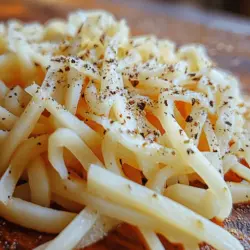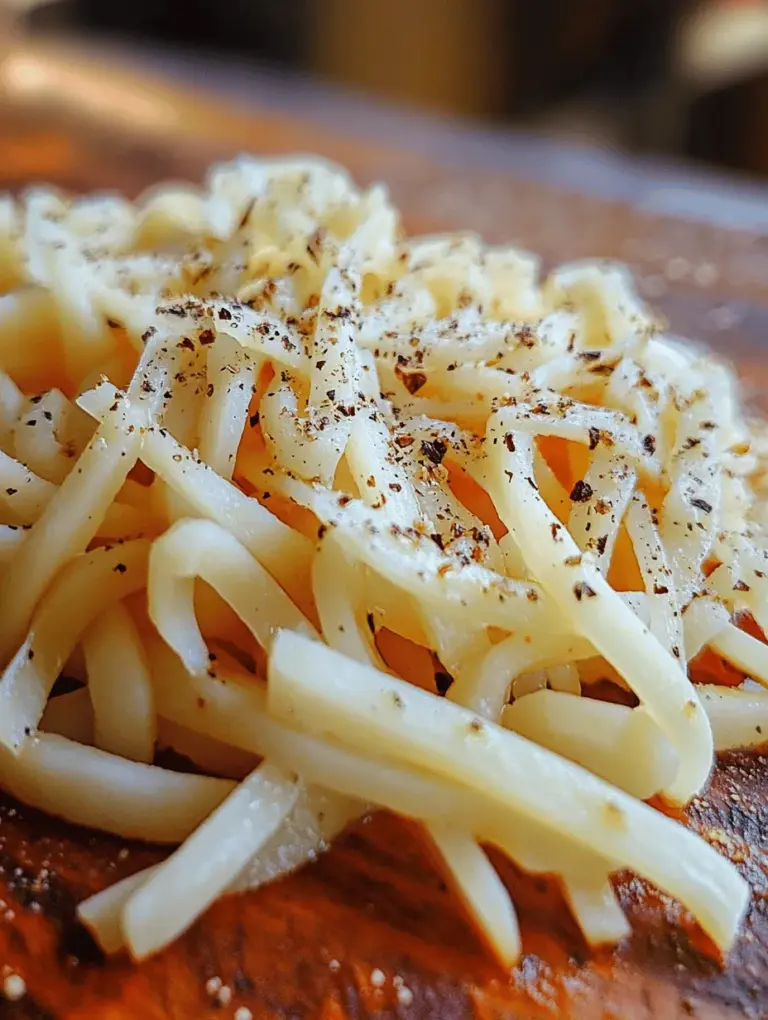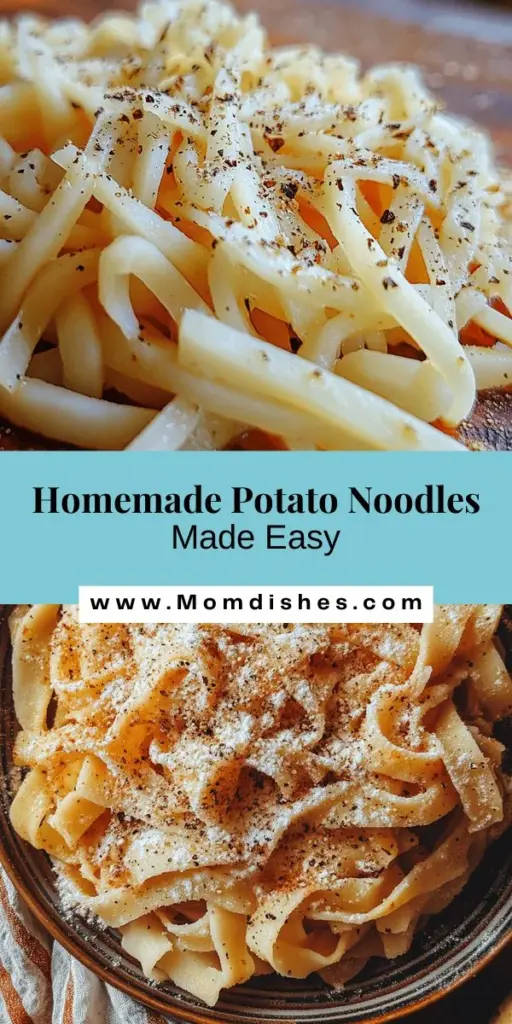Introduction
In recent years, the trend of making homemade noodles has surged in popularity, capturing the hearts of culinary enthusiasts and home cooks alike. The allure of crafting your own pasta offers not only a sense of accomplishment but also the promise of freshness and flavor that store-bought options often lack. Among the myriad of noodle varieties, potato noodles stand out as a comforting and versatile dish that can easily accommodate various sauces, toppings, and seasonings.
What makes potato noodles particularly appealing is their simplicity and accessibility. With just a few basic ingredients, you can transform humble potatoes into delectable noodles that are perfect for any meal. Whether you’re looking for a gluten-free alternative or simply seeking a new way to enjoy potatoes, this recipe for easy potato noodles is sure to please.
The Allure of Homemade Noodles
The trend of making pasta at home has taken the culinary world by storm, with food bloggers and chefs alike showcasing their unique interpretations of traditional recipes. Homemade noodles offer a plethora of benefits that make them a worthy addition to your cooking repertoire. Firstly, the freshness of homemade noodles is unparalleled; they can be enjoyed immediately after preparation, resulting in a delightful texture that is often compromised in mass-produced alternatives.
Moreover, making your own noodles allows for customization that caters to personal tastes and dietary needs. Whether you wish to infuse flavors, adjust thickness, or experiment with different ingredients, the possibilities are endless. The joy of creating a dish from scratch—knowing every ingredient and the care that went into its preparation—adds a personal touch that elevates the dining experience.
Understanding Potato Noodles
Potato noodles, as the name suggests, use potatoes as their primary ingredient, forming a unique and delicious alternative to traditional wheat-based pasta. Their origins can be traced back to various cultures that have historically utilized potatoes in innovative culinary ways, particularly in regions where potatoes are a staple food. This creative use of potatoes not only highlights their versatility but also introduces a delightful twist to the classic noodle experience.
Nutritionally, potato noodles offer several advantages over traditional wheat pasta. Potatoes are rich in vitamins such as Vitamin C and B6, as well as essential minerals like potassium and magnesium. They also provide a good source of dietary fiber, which can aid in digestion and promote a feeling of fullness. For those who are sensitive to gluten or choose to avoid it, potato noodles present an excellent alternative without sacrificing flavor or texture.
When comparing potato noodles to traditional wheat pasta, it’s important to note that potato noodles are generally lighter and can absorb flavors more readily, making them an ideal canvas for sauces and toppings. Their unique texture and taste can create a satisfying meal that is both comforting and refreshing.
Ingredients Breakdown
To create the perfect easy potato noodles, you’ll need just a handful of ingredients. Each one plays a crucial role in achieving the desired flavor and texture.
Russet Potatoes
The star of our dish, russet potatoes, are the ideal choice for making potato noodles. Their starchy composition allows for a light and fluffy texture, which is essential when creating noodles. The high starch content helps bind the ingredients together, ensuring that the noodles hold their shape during cooking. Additionally, russet potatoes have a mild flavor that complements a variety of sauces, making them a versatile base for your culinary creations.
All-Purpose Flour
All-purpose flour serves as a binding agent in this recipe, helping to provide structure to the noodles. When combined with the mashed potatoes, flour helps create a dough that can be rolled out and shaped into noodles. The amount of flour used can be adjusted depending on the moisture content of the potatoes—too much moisture may require additional flour to achieve the right consistency.
Egg
The addition of an egg enhances the richness of the potato noodles, contributing to their overall texture. The egg acts as a binding agent, helping to unify the ingredients and provide elasticity to the dough. This results in a more cohesive noodle that holds up well during cooking.
Salt
Salt is a crucial ingredient that enhances the overall flavor of the noodles. It helps elevate the natural taste of the potatoes and adds depth to the final dish. When preparing the noodles, be sure to incorporate salt into the mixture to ensure that every bite is flavorful.
Olive Oil (Optional)
While olive oil is an optional addition, it can provide extra richness and moisture to the potato noodles. Incorporating a small amount of olive oil can also prevent the noodles from becoming too sticky, making them easier to work with. Furthermore, the subtle flavor of olive oil can complement the dish beautifully.
Freshly Ground Black Pepper
Freshly ground black pepper adds a delightful layer of flavor to the potato noodles. Its warm, spicy notes can enhance the overall taste profile, making each bite more interesting. Seasoning your noodles with black pepper is an easy way to elevate the dish without overwhelming the palate.
Preparation Steps for Easy Potato Noodles
Now that you have a clear understanding of the ingredients, it’s time to dive into the preparation steps for creating your easy potato noodles. Follow these instructions closely to ensure a successful outcome.
Preparing the Potatoes
The first step in making easy potato noodles is to prepare your russet potatoes properly. Begin by washing the potatoes thoroughly under cold running water to remove any dirt or debris. It’s essential to ensure the potatoes are clean, as this will affect the overall quality of the noodles.
Next, peel the potatoes using a vegetable peeler or knife, taking care to remove all the skin. This step is crucial for achieving a smooth texture in the final noodles, as any residual skin could alter the consistency. After peeling, cut the potatoes into evenly sized chunks to promote even cooking.
Boiling Techniques
Once your potatoes are prepped, it’s time to boil them. Fill a large pot with water and add a generous pinch of salt to enhance the flavor. Bring the water to a rolling boil before adding the potato chunks. Boil the potatoes until they are fork-tender, which usually takes around 15 to 20 minutes. It’s important not to overcook the potatoes, as this can lead to a mushy texture that is difficult to work with when making noodles.
Once the potatoes are cooked, drain them well and allow them to cool slightly. This cooling period is essential, as it prevents burns while handling the hot potatoes and allows moisture to escape, leading to a better dough consistency.
Mashing the Potatoes
After the potatoes have cooled, it’s time to mash them into a smooth consistency. You can use a potato masher, ricer, or even a fork to achieve this. The key is to ensure that there are no lumps, as any inconsistencies can affect the texture of the noodles. For the best results, allow the mashed potatoes to cool completely before mixing in the other ingredients.
When mashing the potatoes, consider the final texture you desire for your noodles. The smoother the potatoes are, the more uniform your noodles will be. Once you’ve achieved the desired consistency, you’re ready to incorporate the remaining ingredients into the dough.
Importance of Allowing Potatoes to Cool
Allowing the mashed potatoes to cool is a vital step that should not be overlooked. If you mix the other ingredients into hot potatoes, it can lead to a sticky and difficult-to-handle dough. Cooling the potatoes also allows for better incorporation of the flour, egg, and seasonings, resulting in a more cohesive noodle dough.
With the potatoes properly prepared and cooled, you’re well on your way to crafting delicious potato noodles. Stay tuned for the next steps in this exciting culinary adventure, where we’ll detail the process of forming, cooking, and serving your easy potato noodles!
{{image_1}}
Making the Dough
To create the perfect potato noodles, the first step is to make the dough. The right dough consistency is essential for achieving the desired texture of your noodles, which should be tender yet firm enough to hold up against sauces and toppings.
Process of Mixing Ingredients for Optimal Dough Consistency
Start by gathering your ingredients: mashed potatoes, flour, an egg (if desired for binding), and a pinch of salt. Place the mashed potatoes in a large mixing bowl and gradually add the flour, mixing with a fork or your hands until the dough begins to come together. If you’re using an egg, beat it lightly and add it to the potato mixture at this stage. This additional binding agent can help improve the dough’s overall elasticity and texture.
Knead the dough gently on a floured surface until it becomes smooth and slightly tacky, usually about 5-7 minutes. Be careful not to over-knead, as this can result in a gummy texture. If your dough feels too sticky, incorporate a bit more flour, a tablespoon at a time, until you reach the right consistency. Conversely, if your dough seems too dry and crumbly, a splash of water or an additional egg can help bring it together.
Troubleshooting Common Dough Issues
– Stickiness: If your dough is sticky and clings to your hands or work surface, this is often due to excess moisture in the mashed potatoes. To rectify this, sprinkle a little more flour on the surface as you knead. You can also let the dough rest for 10-15 minutes, allowing the flour to absorb moisture.
– Consistency: If the dough is too dry and not holding together, consider adding a small amount of water or incorporating more mashed potatoes. It should be pliable and easy to handle without crumbling apart.
Rolling the Dough
Once you have your dough ready, the next step involves rolling it out to the desired thickness.
Techniques for Rolling Out Dough Evenly
Flour your work surface generously to prevent sticking. Divide your dough into manageable portions; working with smaller pieces makes it easier to roll thinly and evenly. Use a rolling pin to flatten the dough to your preferred thickness—about 1/8 inch is ideal for potato noodles. Rotate the dough frequently, adding more flour as needed, to ensure an even thickness and prevent sticking.
Importance of Dusting with Flour to Prevent Sticking
Dusting the dough and your rolling pin with flour is crucial. It not only prevents the dough from adhering to the surface but also helps maintain the desired texture of the noodles. Too much moisture can make the noodles gummy, so be liberal with the flour but ensure the dough remains manageable.
Cutting into Noodles
After rolling out the dough, it’s time to cut it into your preferred noodle shape.
Different Shapes and Sizes of Noodles
Potato noodles can come in various shapes, from fettuccine and tagliatelle to thicker pappardelle. The beauty of homemade noodles lies in their versatility. For fettuccine, cut the rolled dough into strips about 1/4 inch wide. For tagliatelle, you can aim for slightly wider cuts.
Best Tools for Cutting Noodles
You can use a sharp knife for straight cuts or a pasta cutter for more uniform shapes. A pizza cutter is also an excellent tool for quickly slicing through the rolled dough. Whichever tool you choose, ensure that it is clean and sharp to achieve clean edges.
Cooking Your Potato Noodles
Now that you have your noodles cut, it’s time to cook them.
Boiling the Noodles
Bring a large pot of salted water to a rolling boil. Salting the water is essential, as it enhances the flavor of the noodles. Once the water is boiling, add your freshly cut potato noodles.
Importance of Salted Water for Flavor
Salted water is crucial for infusing the noodles with flavor while they cook, making them more tasty and enjoyable. Use about 1 tablespoon of salt per quart of water for optimal results.
How to Tell When Noodles are Done Cooking
Potato noodles typically cook faster than traditional wheat noodles, usually taking 3-5 minutes. They are done when they float to the surface and have a tender bite. To check for doneness, taste a noodle; it should be soft but still have a slight bite (al dente).
Drain and Serve
Once your noodles are cooked, it’s essential to drain them properly.
Best Practices for Draining and Tossing Noodles
Carefully pour the noodles into a colander to drain the water. Avoid rinsing them, as this can wash away the flavor. Instead, toss the noodles back into the pot while they’re still hot, allowing any residual heat to evaporate excess moisture.
Suggestions for Flavorful Additions or Sauces
For a simple yet delicious meal, toss the drained noodles with olive oil, garlic, and fresh herbs. Alternatively, you can add them to your favorite sauce. A rich marinara, creamy alfredo, or a zesty garlic herb sauce works wonderfully with potato noodles. For added flavor and nutrition, consider mixing in sautéed vegetables or cooked proteins like chicken, shrimp, or tofu.
Serving Suggestions
Potato noodles are incredibly versatile, making them a fantastic base for various dishes.
Overview of Popular Sauce Pairings
– Marinara: A classic tomato-based sauce that complements the subtle flavor of potato noodles beautifully.
– Alfredo: A creamy option that adds richness and pairs well with the tender texture of the noodles.
– Garlic Herb: A light and fragrant sauce that enhances the natural potato flavor without overpowering it.
Creative Ways to Serve Potato Noodles
Consider combining your potato noodles with seasonal vegetables like spinach, zucchini, or bell peppers for a colorful and nutritious dish. You can also incorporate proteins such as grilled chicken, sautéed shrimp, or chickpeas for a heartier meal. For those with dietary preferences, potato noodles offer gluten-free options when made with gluten-free flour.
Storing and Reheating Leftover Potato Noodles
If you have leftover noodles, proper storage is key to maintaining their quality.
Best Practices for Storing Cooked Noodles
Allow the noodles to cool to room temperature before storing them in an airtight container in the refrigerator. They can last for about 3-4 days. If you want to store them for longer, consider freezing them. Spread the cooked noodles in a single layer on a baking sheet and freeze until firm, then transfer to a freezer-safe bag or container.
Tips for Reheating Without Losing Texture
When it comes to reheating, the best method is to use a sauté pan. Heat a small amount of oil or butter in the pan over medium heat and add the noodles, tossing them gently until warmed through. This method helps revive their texture, preventing them from becoming mushy or overcooked. Alternatively, you can add a splash of water and cover the pan to steam the noodles lightly.
Conclusion
Making your own potato noodles is a rewarding and enjoyable culinary experience. The satisfying process, from preparing the dough to crafting the perfect sauce, allows for creativity in the kitchen. Not only are these noodles easy to make, but they also provide a delightful twist to your regular pasta dishes.
As you experiment with different flavors, sauces, and ingredients, remember that the joy of cooking lies in sharing these homemade meals with friends and family. Whether you choose a simple garlic oil dressing or a rich marinara sauce, your homemade potato noodles are sure to impress. So put on your apron, gather your ingredients, and get ready to savor the delicious flavors of your homemade potato noodles!


